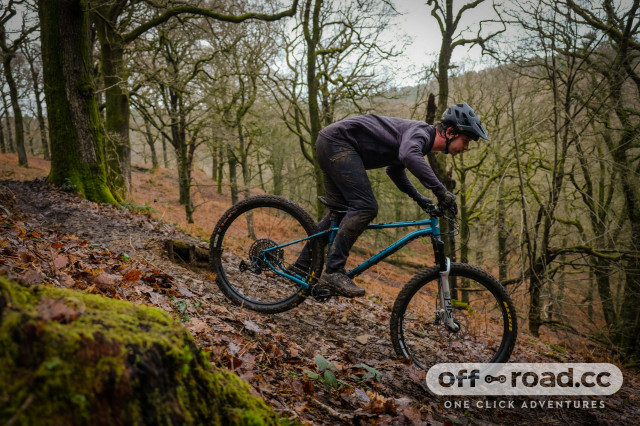Is the hardtail the best winter mountain bike?

Full-suspension mountain bikes reign supreme in most corners of the sport, with double bouncers topping the podium even in cross-country mountain bike racing these days. This comes as no surprise as they allow for more confidence, comfort and speed, all of which overshadow the humble hardtail which has now gained a more niche following. However easily forgotten as they are, hardtails remain the best mountain bikes for winter riding for a multitude of reasons.
- Busting those suspension myths with Fox
- Best mountain bike jackets 2023 - Top weatherproof options for men and women
- Best hardtail mountain bikes 2023 hardtails for every budget
Those who persist throughout the winter months will be fully aware that riding through the rain and slop poses a very different set of challenges. And I’ll admit, full-suspension mountain bikes deal with all of those situations with exemplary performance, translating their dry-weather confidence to the wet stuff with ease. However, when things are wet the simplicity of a hardtail really shines through.
A hardtail in the wet is a great way to hone skills
Even aboard a full susser, winter or wet weather, in general, provides one of the best platforms for working on your riding skills. There’s nothing like minimal traction to get you really thinking about what you’re doing on a bike and how your body position affects grip. Even the best riders in the professional categories will be aware that proficiency in wet riding can win races – Charlie Hatton’s now-famous World Cup win is a perfect example.
Ditching the rear suspension seriously brings riding back to basics as there’s absolutely no forgiveness at the rear of a hardtail that can get you out of trouble should you set a tyre wrong. Excellent bike handling skills become far less point-and-shoot. Instead, the stiffness of a hardtail will force you to choose the smoothest and most forgiving line a trail can offer, which often tends to be the quickest line.
It’ll also teach you when and where it’s best to hop over trail obstacles, rather than rattle through them. Again, a hardtail has very little give in its rear end, so charging over a rock garden isn’t without risk to discomfort, stability and foot security on the pedals (if riding with flat pedals). Hopping over such obstacles completely negates those risks if done correctly. There’s also the important lesson of keeping your heels down but granted, these are both lessons that can be taught in all conditions.
Riding with minimal tools will only help you use those tools better when you have them at your disposal. Then add the greater unpredictability in the wet, and lack of grip and you’ll be a force to be reckoned with as soon as the trails dry out.
Less maintenance required
Winter is wet, winter is mucky and, as a result, components and consumables can wear much faster especially pivot bearings. Pivot bearings serve as the lifeblood of all full-suspension mountain bikes as they allow the rear wheel to move through its travel smoothly. As bearings wear, they develop play which can go as far as to affect the bike’s handling and it can even result in frame-ending damage if left too long.
Water ingress that occurs when smashing puddles too frequently, while washing and riding in gritty conditions speeds up the wear process. After a full winter’s riding, you may have to replace some or all of those bearings which is a time-consuming, and costly repair.
While there are still bearings in the headset, wheels and bottom bracket, a hardtail has no rear suspension – nor does it have pivot bearings. So that’s one less cost to worry about when riding throughout the winter. It’s also much easier to replace headset bearings for example, than pivot bearings, so you won’t have to shell out for a mechanic as regularly.
Easier to clean
The state of our bikes after a wet ride is a sight we know all too well. Thick mud somehow finds its way into places we don’t even know exists, even with the best mudguards equipped. To get most full suspension frames shining to their former glory, you’ll be reaching for the brushes and spending a good amount of time hosing muck from the inner faces of a rocker link.
Thanks to a hardtail’s simple-as-ever design, time cleaning the bike is reduced to a minimum. Sometimes, if tended to soon enough, you can blast the frame with a hose and the bike will be clean enough, ready for the next spin. If you hate cleaning, a hardtail may be the bike for you.
They pedal better
As tyres clog and the bike gets heavy as more and more mud clings to it, a full-suspension mountain bike can feel lethargic when pushing on the pedals for a mid-decent boost in speed or during a traverse. That’s in part due to their overall greater weight and the fact that many suspension platforms waste energy to excess movement in the rear shock.
While a marginal amount of power may be lost to flex in the frame, depending on the material, a hardtail’s power delivery is as direct as it gets and when you’re pedalling through slop that pays back in a huge boost in momentum. And when you’re generally riding slower due to wintery conditions, this almost perfect power delivery really comes into its own as it makes extra speed through the odd pedal stroke or two much easier to deliver.












